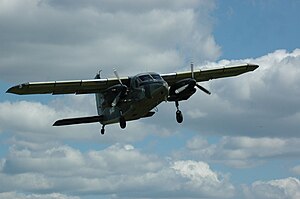Dornier Do 128
| Do 28 Skyservant | |
|---|---|
 |
|
| Dornier Do 28 G.92 turboprop conversion | |
| Role | STOL light utility aircraft |
| Manufacturer | Dornier Flugzeugbau GmbH |
| First flight | 29 April 1959 |
| Status | In civilian and military use |
| Primary user | German Air Force |
| Developed from | Dornier Do 27 |
| Developed into | Dornier Do 228 |
The type designation Dornier Do 28 comprises two different twin-engine STOL utility aircraft, manufactured by Dornier Flugzeugbau GmbH. Most of them served with the German Air Force and Marineflieger and other air forces around the world in the communications and utility role. The Do 28 series consists of the fundamentally different Do 28 A/B (1959) and Do 28 D Skyservant (1966).
The Do 28 was developed from the single-engine Do 27 at the end of the 1950s. The design shared the high-wing cantilever layout and the lift augmentation devices of the Do 27, together with the rear fuselage which seated six passengers.
The most defining feature of the new design was the unusual incorporation of two Lycoming engines, as well as the two main landing gear shock struts of the faired main landing gear attached to short pylons on either side of the forward fuselage. The internal space of the Do 28 was the same as the Do 27.
Like the Do 27, the Dornier Do 28 possessed a high cruising speed, excellent low-speed handling characteristics, as well as very short takeoff and landing (STOL) performance. The Do 28 was readily accepted as a natural progression from its single-engine forebear. With many of the same STOL characteristics, most Do 28 production was destined for military customers, notably Germany, although a small number were in service for commercial operators as a rugged, low-cost utility transport. The design proved remarkably adaptable and was developed into a number of progressively improved variants, from the original D, through the D1 and D2 to the 128-2, introduced in 1980. Each variant introduced a number of detail changes that enhanced its already versatile performance capabilities.
The Dornier company was given financial assistance from the German government to develop a larger STOL transport to carry up to 13 passengers. The type was designated the Do 28D and later named Skyservant. The Do 28D was a complete redesign and shared only the basic layout and wing construction of the earlier versions. The fuselage and engine nacelles were rectangular, unlike the rounded Do 28A/B. The aim was to develop a simple and rugged aircraft for use under arduous conditions, which could be easily maintained. With a crew of two pilots, the cabin accommodated up to 12 passengers; freight could be loaded easily through large double doors and with the seats removed the cabin gave 283 sq ft (26.3 m2) of unobstructed space. The first flight of a Do 28D took place on 23 February 1966 and the type was publicly exhibited at the Paris Air Show at Le Bourget airport in June 1967.
...
Wikipedia
